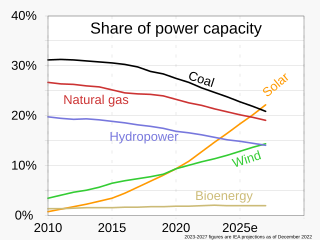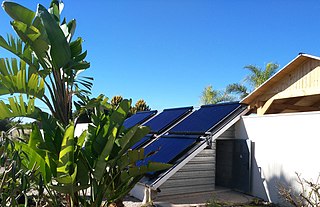Related Research Articles

Renewable energy is energy from renewable resources that are naturally replenished on a human timescale. Renewable resources include sunlight, wind, the movement of water, and geothermal heat. Although most renewable energy sources are sustainable, some are not. For example, some biomass sources are considered unsustainable at current rates of exploitation. Renewable energy is often used for electricity generation, heating and cooling. Renewable energy projects are typically large-scale, but they are also suited to rural and remote areas and developing countries, where energy is often crucial in human development. Renewable energy is often deployed together with further electrification, which has several benefits: electricity can move heat or objects efficiently, and is clean at the point of consumption.

Solar water heating (SWH) is heating water by sunlight, using a solar thermal collector. A variety of configurations are available at varying cost to provide solutions in different climates and latitudes. SWHs are widely used for residential and some industrial applications.

Energy development is the field of activities focused on obtaining sources of energy from natural resources. These activities include the production of renewable, nuclear, and fossil fuel derived sources of energy, and for the recovery and reuse of energy that would otherwise be wasted. Energy conservation and efficiency measures reduce the demand for energy development, and can have benefits to society with improvements to environmental issues.

Energy is sustainable if it "meets the needs of the present without compromising the ability of future generations to meet their own needs." Most definitions of sustainable energy include considerations of environmental aspects such as greenhouse gas emissions and social and economic aspects such as energy poverty. Renewable energy sources such as wind, hydroelectric power, solar, and geothermal energy are generally far more sustainable than fossil fuel sources. However, some renewable energy projects, such as the clearing of forests to produce biofuels, can cause severe environmental damage.

Microgeneration is the small-scale production of heat or electric power from a "low carbon source," as an alternative or supplement to traditional centralized grid-connected power.

A Zero-Energy Building (ZEB), also known as a Net Zero-Energy (NZE) building, is a building with net zero energy consumption, meaning the total amount of energy used by the building on an annual basis is equal to the amount of renewable energy created on the site or in other definitions by renewable energy sources offsite, using technology such as heat pumps, high efficiency windows and insulation, and solar panels.

Renewable energy commercialization involves the deployment of three generations of renewable energy technologies dating back more than 100 years. First-generation technologies, which are already mature and economically competitive, include biomass, hydroelectricity, geothermal power and heat. Second-generation technologies are market-ready and are being deployed at the present time; they include solar heating, photovoltaics, wind power, solar thermal power stations, and modern forms of bioenergy. Third-generation technologies require continued R&D efforts in order to make large contributions on a global scale and include advanced biomass gasification, hot-dry-rock geothermal power, and ocean energy. As of 2012, renewable energy accounts for about half of new nameplate electrical capacity installed and costs are continuing to fall.

Renewable energy in Finland grew to 38.7% of total final energy consumption by year end 2014, achieving joint second position with Latvia in terms of renewable energy consumption by share amongst the EU-28 countries, behind its neighbour Sweden in first position on a 52.6% share. The 2014 share in Finland breaks down as renewable energy providing 52% of the heating and cooling sector, 31.4% of the electricity sector and 21.6% of the transport sector. By 2014, Finland had already exceeded its 2020 target for renewable energy use under the EU renewable energy directive as shown in the table of country targets.
Don Stephens is a futurist, eco-home sustainable designer and author. He has published books in the field of what he terms "optimized self-sufficiency" for a range of uncertain-future scenarios, that is also labeled survivalism by others.

The renewable-energy industry is the part of the energy industry focusing on new and appropriate renewable energy technologies. Investors worldwide have paid greater attention to this emerging industry in recent years. In many cases, this has translated into rapid renewable energy commercialization and considerable industry expansion. The wind power, solar power and hydroelectric power industries provide good examples of this.

Multifuel, sometimes spelled multi-fuel, is any type of engine, boiler, or heater or other fuel-burning device which is designed to burn multiple types of fuels in its operation. One common application of multifuel technology is in military settings, where the normally-used diesel or gas turbine fuel might not be available during combat operations for vehicles or heating units. Multifuel engines and boilers have a long history, but the growing need to establish fuel sources other than petroleum for transportation, heating, and other uses has led to increased development of multifuel technology for non-military use as well, leading to many flexible-fuel vehicle designs in recent decades.

As of 2019, renewable energy technologies provide about 17.3% of Canada's total primary energy supply. For electricity renewables provide 67%, with 15% from nuclear and 18% from hydrocarbons.
George Oscar Löf was an American engineer and inventor who was best known for his contributions to solar energy research. "Nobody played a more enduring role in the 20th century solar house movement than George Löf."

Bioliquids are liquid fuels made from biomass for energy purposes other than transport.
The North Carolina Solar Center is a resource center for sustainable energy programs located at North Carolina State University in Raleigh, North Carolina. When it was created in 1988, the center's focus was solar energy. The N.C. Solar Center now serves as a resource for innovative clean energy technologies through demonstration, technical assistance, outreach, and training. It also administers the Database of Encouragement for Renewables & Efficiency (DSIRE), a resource providing financial encouragement and policies in the energy industry.

Renewable energy has developed rapidly in Italy over the past decade and provided the country a means of diversifying from its historical dependency on imported fuels. Solar power accounted for around 8% of the total electric production in the country in 2014, making Italy the country with the highest contribution from solar energy in the world that year. Rapid growth in the deployment of solar, wind and bio energy in recent years lead to Italy producing over 40% of its electricity from renewable sources in 2014.

Approximately 40% of primary energy is from renewable energy sources in New Zealand. Approximately 80% of electricity comes from renewable energy, primarily hydropower and geothermal power.

Energy in the U.S. state of Hawaii is produced from a mixture of fossil fuel and renewable resources. Producing energy is complicated by the state's isolated location and lack of fossil fuel resources. The state relies heavily on imports of petroleum. Hawaii has the highest share of petroleum use in the United States, with about 62% of electricity coming from oil in 2017. As of 2021 renewable energy made up 34.5%.

A clean-burning stove is a stove with reduced toxic and polluting emissions. The term refers to solid-fuel stoves such as wood-burning stoves for either domestic heating, domestic cooking or both. In the context of a cooking stove, especially in lower-income countries, such a stove is distinct from a clean-burning-fuel stove, which typically burns clean fuels such as ethanol, biogas, LPG, or kerosene. Studies into clean-burning cooking stoves in lower-income countries have shown that they reduce the emissions of dangerous particulates and carbon monoxide significantly, use less fuel than regular stoves, and result in fewer burn injuries. However, the emissions some supposedly clean-burning cookstoves produce are still much greater than safe limits, and in several studies in lower income countries they did not appear to be effective at reducing illnesses such as pneumonia induced by breathing polluted air, which may have many sources.

Renewable energy in South Africa is energy generated in South Africa from renewable resources, those that naturally replenish themselves—such as sunlight, wind, tides, waves, rain, biomass, and geothermal heat. Renewable energy focuses on four core areas: electricity generation, air and water heating/cooling, transportation, and rural energy services. The energy sector in South Africa is an important component of global energy regimes due to the country's innovation and advances in renewable energy. South Africa's greenhouse gas (GHG) emissions is ranked as moderate and its per capita emission rate is higher than the global average. Energy demand within the country is expected to rise steadily and double by 2025.